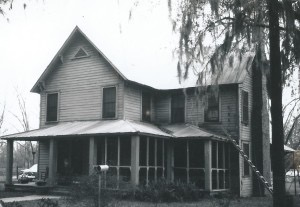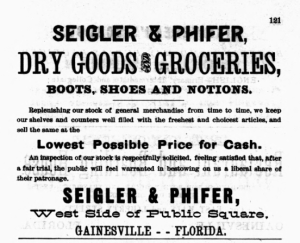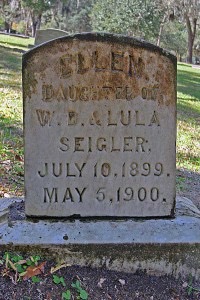History Revealed: Profile of an Historic Waldo Home and its Inhabitants, Part I
A special guest blog from Ellie Floyd, Waldo, FL

It sits high on Cracker Hill, an imposing edifice beckoning the visitor to discover its secrets… at least, that’s how I felt upon seeing our home, the Seigler-Kinzer house, for the first time. It is only a block from State Road 24, but is shielded by the old Seay bungalow and its massive, sprawling oak across a limerock road. Just beyond our backyard, the old Granger house and its tree canopy provide a picturesque borrowed landscape.
The frame vernacular-style dwelling began as a simple gable-front shape, two rooms deep. A western addition transformed it into a gable-front-and-wing, though it has an irregular plan due to later additions on the south side. Much of the original cypress drop-siding remains on the exterior of this traditionally white house, while decorative corbels under the eaves of the old shingle and tin roof give it a Folk-Victorian feel. The wraparound front porch has undergone several alterations, and as the ceiling paint begins to shed its most recent layer, the “haint blue” underneath is being revealed. In the southern tradition, that shade was thought to ward off spirits.
Andrew and I may be only the third family group to own this house in Sparkman’s Addition during its 120+-year history, having purchased the nearly half-acre lot from the Womeldurf family two years ago. We are undertaking a part renovation/part restoration of the old house, which is recorded in the Florida Master Site File as an architecturally significant structure for the town of Waldo. This project has been a humbling and eye-opening experience; discovering the lives of those who dwelt in this house while revealing its physical layers gives every board and nail meaning.
The exact date of construction and builder of the house is uncertain. The land the house sits upon was first owned by the Florida Railroad Company before it was transferred, by trustees Soutter and McRae, to the Blakes in 1867. Peter William Washington Sparkman became the landholder in 1871, and owned a grist mill and packing plant near his home in this area. Over the next ten years, the land subsequently passed through the hands of Robert Weeks, Abraham Crosby, and James Sparkman. In 1881, P.W.W. Sparkman reacquired the land; he divided the uniquely-shaped parcel, lying between the Transit and Peninsular Railroads, into multiple lots.
 From 1881 to 1884, a section of lots R, S, T, and U in Sparkman’s Addition was owned by Mary Weeks, then Julia Blackstock, and later James Weeks. Our house is on lot U, which was not sold individually until James Weeks deeded it to Lula Seigler for $500 in 1894. He’d sold lots R, S, and T combined for the same price in 1890, which seems to suggest that a structure was already in existence on Lot U when Seigler purchased it. Conversely, her family would own the property for 47 years, a much longer period during which to create a home. Charles Womeldorf, who most recently owned the house, remembers a conversation he had with Lula Seigler’s daughter, Isla: she said she was a young girl when her father, William David Seigler, built the house. At the same time, he recollects seeing an old window on the second floor etched with the year “1870.” This raises the question of whether the house was constructed with materials taken from an older home, or whether the Seiglers simply added onto an existing building. At the very least, we are certain that the rear kitchen addition was built under their ownership, as old boards we exposed in the ceiling there were inscribed: “Mrs. L.D. Seagler, Waldo, Fla.”
From 1881 to 1884, a section of lots R, S, T, and U in Sparkman’s Addition was owned by Mary Weeks, then Julia Blackstock, and later James Weeks. Our house is on lot U, which was not sold individually until James Weeks deeded it to Lula Seigler for $500 in 1894. He’d sold lots R, S, and T combined for the same price in 1890, which seems to suggest that a structure was already in existence on Lot U when Seigler purchased it. Conversely, her family would own the property for 47 years, a much longer period during which to create a home. Charles Womeldorf, who most recently owned the house, remembers a conversation he had with Lula Seigler’s daughter, Isla: she said she was a young girl when her father, William David Seigler, built the house. At the same time, he recollects seeing an old window on the second floor etched with the year “1870.” This raises the question of whether the house was constructed with materials taken from an older home, or whether the Seiglers simply added onto an existing building. At the very least, we are certain that the rear kitchen addition was built under their ownership, as old boards we exposed in the ceiling there were inscribed: “Mrs. L.D. Seagler, Waldo, Fla.”
Lula A. Deupree and William David Seigler were married in 1885 at the First Baptist Church of Gainesville, having children Isla in 1889 and Harry David in 1891. The family unit lived in the town of Waldo from at least 1891 on, and at some point before moving to the house in Sparkman’s Addition, William had lived in the “J.B. Schuman” house, likely while it was under the ownership of C.K. Dutton. The design of that house, now owned by Mary Baxla, bears similarities to ours.
Lula was born in Ladonia, Texas in 1860 to Elijah Deupree, a dry goods merchant, and his wife, Harriet. The Deuprees lived for a time in Mississippi before moving to Gainesville in 1878. After Elijah’s death in 1896, Harriet joined her daughter Lula’s new family in their Cracker Hill home; she lived here with them until her death in 1920.
 William, or W.D., was born in 1857 in Florida, his family being settled in Putnam County by 1860. His parents, Marshal Seigler and Permelia Ellen Johnson, hailed from South Carolina. Marshal, who would later become a co-founder of the Etoniah Canal and Drainage Company, began his career as a general merchant in Waldo. His business was called Seigler & Johnson, his partner likely his brother-in-law. He notably employed William Baxter Phifer, who later opened his own store in Waldo with Marshal’s son, W.D. In 1882, the young merchants sold that business and opened Seigler & Phifer in Gainesville. Their ad appeared in the 1883 publication, The Eden of the South. At the end of that year, they closed their Gainesville store and began a new venture in Rochelle. How long they remained partners is unclear. Phifer eventually went into business with his brothers, and together they opened the Phifer State Bank.
William, or W.D., was born in 1857 in Florida, his family being settled in Putnam County by 1860. His parents, Marshal Seigler and Permelia Ellen Johnson, hailed from South Carolina. Marshal, who would later become a co-founder of the Etoniah Canal and Drainage Company, began his career as a general merchant in Waldo. His business was called Seigler & Johnson, his partner likely his brother-in-law. He notably employed William Baxter Phifer, who later opened his own store in Waldo with Marshal’s son, W.D. In 1882, the young merchants sold that business and opened Seigler & Phifer in Gainesville. Their ad appeared in the 1883 publication, The Eden of the South. At the end of that year, they closed their Gainesville store and began a new venture in Rochelle. How long they remained partners is unclear. Phifer eventually went into business with his brothers, and together they opened the Phifer State Bank.
W.D. ultimately became a general merchant in his own right. His Waldo store purveyed, among other goods; boots, fashions, paints, fertilizer, and groceries like Ballard’s Obelisk flour. The Gainesville Daily Sun of 1905 called him “one of the oldest established and most successful merchants of Waldo.” He was a Mason, as well as an early member of the Odd Fellows, Union Lodge, No. 2.
The Seiglers were much involved in the social events taking place in Waldo just after the turn of the century. For the crystal wedding of the Langs in March 1907, Lula Seigler assisted in receiving the guests, and at the twentieth anniversary of the Grangers on May 4th, her daughter Isla Seigler helped serve the luncheon. A gem of an article appeared in the February 3rd, 1907 issue of the Sun about an “Old Ladies’ Tea Party” given in the home of Mrs. Seigler. The party was comprised of “eleven ladies whose united ages amounted to 760 years.”
The family would be forever changed by what took place on May 14th, 1907. A headline in the Sun read “W.D. Seigler Suddenly Expired,” and the Live Oak Daily Democrat’s front page announced, “Seigler Dropped Dead.” He had experienced heart failure as he was walking along a street in Waldo. The Sun stated: “[His] demise will cause general regret, as deceased was well-known and popular in Waldo.” His funeral was held at the Seigler residence, with ceremonies befitting his status as a Mason. Many attendees paid their respects, including his old business associate, W.B. Phifer.

W.D. Seigler’s death was not the only tragedy Lula Seigler experienced in that decade; they’d had a third child in 1899, Ellen, who died less than a year later, in 1900. Challenging times followed her husband’s passing. After becoming administratrix of his estate, Lula held an auction for the entire stock of Seigler merchandise, though she did end up buying out a good deal of it. On July 25th, 1907, the Sun remarked, “It is not known whether Mrs. Seigler will continue the business or close the same out. The business has always proved a prosperous one, and friends are suggesting that she continue it.” She did continue as a merchant – for how long it is unclear, though the store was in operation through at least 1910.
Isla Seigler was described by the Sun as “an attractive young lady of Waldo.” She was also tall – at 5’10”, she equaled her husband, Lewin Dennis Kinzer, in height. The couple married in 1910 in Duval County. L.D. Kinzer came from Blacksburg, Virginia; he was an engineer on the Seaboard railway, as well as secretary for the Florida division of the Brotherhood of Locomotive Engineers. The Kinzers lived for a time in Tampa before moving back to Waldo in 1920. That year, Isla joined Waldo Chapter No. 120 of the Order of the Eastern Star as a charter member. In 1922, Lula Seigler deeded her home over to Isla, though she herself continued to live there. The registry of Waldo voters in 1921 lists Lula as the proprietor of a hotel, the name and location of which have remained elusive to me; I wonder if it could have been this very house.
Tragically, Isla became a widow at an even younger age than her mother had, when L.D. Kinzer passed away in 1930. He died at home following a heart attack, the same as had befallen W.D. Seigler. The widowed mother and daughter continued on together. Later owner of the house, Charles Womeldorf, grew up directly next door. He recalls that the two women did not socialize much at that time, and remembers, in good humor, being chastised by them to behave quietly while he and his siblings would play ball in the road. Isla did her part for the community during the Depression; she was a special aid worker for the Federal Emergency Relief Administration, and later became the County Sewing Room Supervisor for the WPA.
Property records show that the household was keeping up with the times, as they owned a Dodge sedan by 1929, and according to the 1930 federal census, a radio set. As Andrew and I worked late one night plying rows of nails out of the newly exposed wide-plank pine floors downstairs, we, too, listened to a radio set – only this one was contained within a small cube. The program was discussing FDR’s fireside chats. I imagined that the original owners of those floors might have listened to the real thing on their radio set in that very same room.
Harry Seigler, W.D. and Lula’s second child, became a conductor for the Seaboard railway after attending school for a time in Meridian, MS. After he married Bobbie Myers, they moved into the house on the corner of the next block, at the intersection of what were once called Place Street and old Gainesville Road. That house was, until just recently, owned by the Williams family. Harry was a member of the Brotherhood of Railway Trainmen. He moved with his wife and two surviving children to Tampa in 1931, and died there in 1960. I believe the children of his son, Charles William Seigler, would be the only descendants of W.D. and Lula Seigler alive today.
In 1941, Isla Kinzer entered into an agreement with the Womeldurf family by which they would rent the home and eventually become the property’s new owners. In 1948, Mrs. James F. (Lillian) Womeldurf was granted the deed to lots U and T (lot T became a part of the Seigler/Kinzer land in 1905).
 Isla and Lula moved to Gainesville following the Agreement in 1941, and lived in a house on University Avenue across from the Kirby Smith building. Just as her husband’s death made headlines in 1907, news of Lula Seigler’s passing in 1955 appeared on the front page of the Gainesville Sun: “Mrs. Seigler, 94, Taken by Death.” Isla Kinzer moved to Tampa a few years after her mother’s death, and passed away there in 1975. All of the Seiglers and Kinzers, with the exception of Harry and his descendants, are buried in Evergreen Cemetery in Gainesville; Harry and his first wife are interred at Laurel Grove Cemetery in Waldo.
Isla and Lula moved to Gainesville following the Agreement in 1941, and lived in a house on University Avenue across from the Kirby Smith building. Just as her husband’s death made headlines in 1907, news of Lula Seigler’s passing in 1955 appeared on the front page of the Gainesville Sun: “Mrs. Seigler, 94, Taken by Death.” Isla Kinzer moved to Tampa a few years after her mother’s death, and passed away there in 1975. All of the Seiglers and Kinzers, with the exception of Harry and his descendants, are buried in Evergreen Cemetery in Gainesville; Harry and his first wife are interred at Laurel Grove Cemetery in Waldo.
To be continued…
Author’s note: Information was attained from a variety of sources, including but not limited to: personal interviews, deeds, newspaper articles, and records held by the Waldo Historical Society. For details, or if you have additional information, please contact:
akemfloyd@gmail.com.